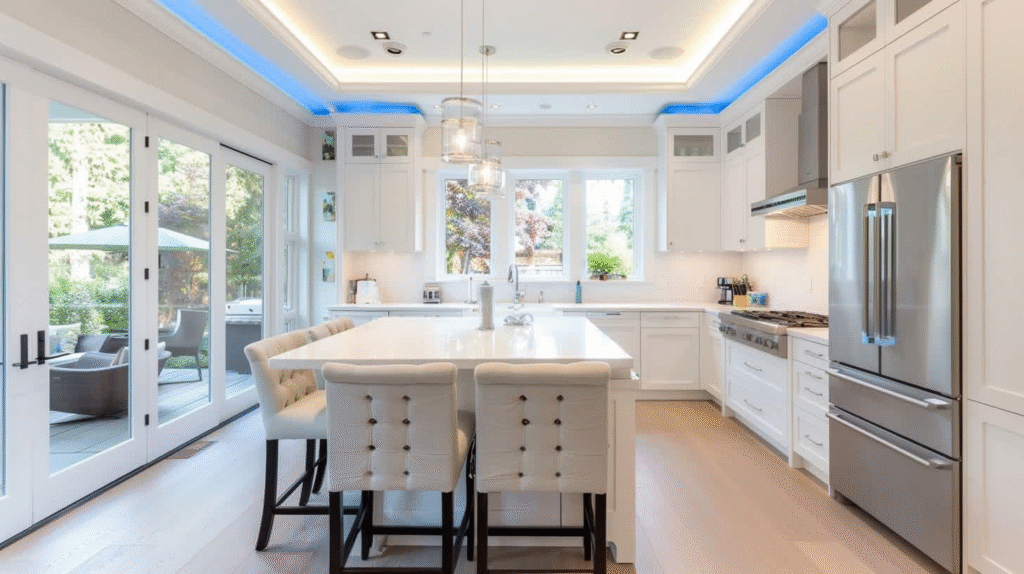
Initially, when the subject of crown molding comes up, the first thing that pops up in people’s minds is an elegantly wooden trim that surrounds the ceiling and has a timeless charm. But the present-day homeowners and designers are completely out of the box thinking, viewing and accepting new materials that are lighter, cheaper, and imperceptibly more difficult to install but still beautiful. Modern alternative crown molding options are made to these expectations and are providing very creative possibilities that are already well beyond classic wood.
At Creative Crown, we have witnessed this change instantly. Homeowners and contractors are adopting innovation not only for style but also for practicality and simplicity in installation. To take a deeper step into the new materials that redefine molding today.
Foam Crown Molding: Lightweight and DIY-Friendly
For a lot of DIY lovers, foam crown molding has been a new way of doing things. It is made of high-density polystyrene or polyurethane, this gives very sculptured design without the inconvenience of heavy daunting wood and complicated cutting. Foam molding is extremely light so that sometimes it can be installed with just glue and no nails or power tools needed.
Thus this is very suitable for those who are doing crown molding by themselves. You do not have to be a skilled carpenter to obtain that nice-looking results. Besides, installation and painting of foam moldings supply are very flexible that it can even match the decor of the home perfectly. It does not matter if you are revamping a living room, molding the ceiling, or adding luxury to a bathroom, foam is a cheap and yet elegant way out.
What else is new? Foam has a number of benefits: Resistant to moisture, warping, and cracking, and thus make it ideal for high-humidity areas where wood fails.
PVC and Polyurethane: Built for Durability
PVC (polyvinyl chloride) and polyurethane moldings are two of the most durable options such as those made of metal, glass, or concrete. The materials were first used in commercial places where durability was the main requirement but synthetics quickly gained popularity in residential design due to their attractive and modern finishes.
Crown molding in PVC can be put into the kitchen and bathroom as well as the outside. This is because, being a non-absorbent material, it will neither take in moisture nor expand. Moreover, it is very easy to clean and maintain; at the end of the day, a quick wipe-down is enough to keep it looking brand new. In contrast, polyurethane has the same finish as wood but is so much less likely to crack or split.
These materials are also very flexible and can easily be used on curved walls and uneven surfaces, which is a problem when using wood. Pretty much the same, the companies present them in range of detailed designs, starting from the simplest contemporary lines and going through the most complex histories motifs, thus offering the possibility of customizing one’s style without all the hassle of wood maintenance.
MDF: The Cost-Effective Classic Substitute
Medium-density fiberboard, or MDF, has long been recognized as a practical alternative to solid wood. It is a product that is composed of wood fibers bound by a resin which results in a product that is inexpensive yet very much able to be painted to look like hard wood.
MDF is the material that is most suitable for interior use, particularly in places where there is no problem with humidity and that have very low moisture content. The ceilings that have MDF moldings can be painted quickly and easily since they can be already primed. In addition, they can be cut and installed with much less risk of splitting; thus, they gain an advantage over the traditional wood trims in this aspect.
MDF may not be as lightweight as foam but it is still a good option for homeowners who want a slightly heavier look without paying the cost or going through the difficulty of dealing with real wood.
Flexible Molding: The Key to Curved and Unique Designs
Traditional moldings have a hard time coping with the installation of a curved wall, arches, and irregular ceilings. To this, however, the flexible crown molding materials give a perfect solution. Having been made from bendable polymers or rubber-like compounds, flexible moldings adapt to bizarre shapes without any effort, thus assuring a seamless fit and polished finish.
In addition to standard materials, the designers have been using flexible molding to reach custom results in innovative spaces. Flexible molding is used to add trim to a dome ceiling or to wrap around a curved staircase wall, and it provides the liberty that wood cannot.
Modern Materials Are the Game Changers
The main reason why these alternative crown molding materials attract such great interest is not their practicality, but rather the fact of giving homeowners and contractors a chance to be more creative when choosing. The use of lighter, more adaptable materials makes the installation not only heavy lifting but also creative design.
Eco-friendly production methods are becoming more common as options of production involving foam and polyurethane can use recycled components, thus reducing the environmental impact while maintaining the quality of the product.
Now, modern crown moldings have found the right spot between innovation and tradition offering the same elegance of wood along with the perks of advanced materials.
At Creative Crown, we are proud to help the owners and designers realize the potential of modern craftsmanship combined with the imagination. Whether you are dealing with a DIY crown molding project or a massive renovation, the investigation of these new materials might completely change your perception of crown molding.